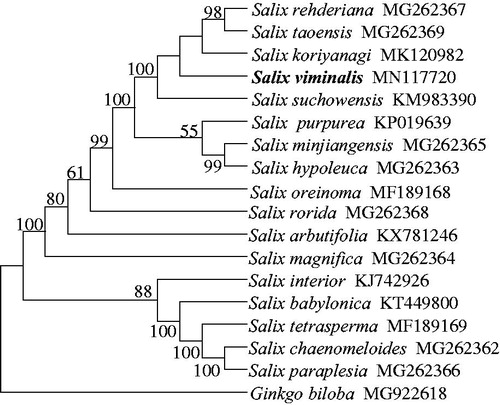Abstract
Here, the complete chloroplast (cp) genome of Salix viminalis was reported. The genome is 155,531 bp long, with a GC content of 36.71%, and contains four sub-regions: 84,395 bp of large single copy (LSC) and 16,218 bp of small single copy (SSC) regions, separated by 27,459 bp of inverted repeat (IR) regions. A total of 129 genes were annotated, including 83 protein-coding genes, 38 tRNA genes, and 8 rRNA genes. The Phylogenetic analyses based on the whole cp genome sequence placed S. viminalis into a clade containing Salix rehderiana, Salix taoensis, Salix koriyanagi, and Salix suchowensis. This is the first complete cp genome for S. viminalis that would be useful for phylogenetic and population genetic studies of this species.
The basket willow Salix viminalis is a vigorous, fast-growing shrub willow species and belongs to the genus Salix, the largest genus of Salicaceae with 500 species worldwide (Argus Citation1997). Salix viminalis is widely distributed into Europe and Asia. Its most familiar use is for basket-making and fencing. In recent years, it has become familiar as the plant used to absorb heavy metals in contaminated sites and is planted commercially for bio-fuel. We also use it to rear Chinese oak silkworm Antheraea pernyi, one of the most known wild silkworms. In this study, we assembled and characterized the complete chloroplast (cp) genome of S. viminalis for the first time in order to provide basic genetic information for this important species. The complete cp genome of this species has been deposited into GenBank under accession no. MN117720.
We obtained a specimen of S. viminalis from the Silkworm Experimantal Field of Shenyang Agricultural University (N41°50′1.08′′; E123°34′21.92′′), Shenyang, China. The fresh leaves from one single individual were used to extract the total DNA. The specimen was stored with the archival number of SAL_VIM_01 at Department of Sericulture of Shenyang Agricultural University. The genome sequencing was performed using Hiseq 4000 platform by Shanghai Personal Biotechnology Co. Ltd, China. A reference-guided assembly was used to reconstruct the chloroplast genome, with Salix koriyanagi (MK120982; Kim et al. Citation2019) as the reference. The complete cp genome was manually annotated by comparing with the published cp genomes of Salix species.
The cp genome of S. viminalis is 155,531 bp in length and has a typical circular structure including a pair of inverted repeat (IRs) of 27,459 bp, separated by a large single-copy region (LSC) of 84,395 bp and a small single-copy region (SSC) of 16,218 bp. The overall GC content of S. viminalis is 36.71% and in the LSC, SSC, and IR regions are 34.45, 30.97, and 58.13%, respectively. In the cp genome of S. viminalis, a total of 129 genes were annotated, of which 110 were unique, consisting of 76 protein-coding genes, 30 tRNA genes, and 4 rRNA genes. Eight protein-coding, seven tRNA, and all four rRNA genes were duplicated in IR regions. In total, 23 intron-containing genes were found, with 4 genes having two introns and 19 genes having one intron.
We then selected 16 Salicaceae cp genomes available, together with S. viminalis, to evaluate the phylogenetic position of S. viminalis within the Salix genus. The phylogenetic tree was reconstructed with MEGA X using maximum-likelihood analysis with GTR + G model (Kumar et al. Citation2018). The phylogenetic relationships among Salix species were supported with moderate to high bootstrap values () and were in line with previous study based on cp genomes where S. viminalis was not included (Park et al. Citation2019). Our phylogenetic analysis placed S. viminalis into a clade containing Salix rehderiana, Salix taoensis, Salix koriyanagi, and Salix suchowensis, consistent with the study based on morphological characters (Kuzovkina and Volk Citation2009).
Disclosure statement
The authors declare no competing financial interest. The authors alone are responsible for the content and writing of the paper.
Additional information
Funding
References
- Argus GW. 1997. Infrageneric classification of Salix (Salicaceae) in the new world. Syst Bot Monographs. 52:1–121.
- Kim J, Kim Y, Park J. 2019. Complete chloroplast genome sequence of the Salix koriyanagi Kimura ex Goerz (Salicaceae). Mitochondrial DNA Part B: Res. 4:549–550.
- Kumar S, Stecher G, Li M, Knyaz C, Tamura K. 2018. MEGA X: molecular evolutionary genetics analysis across computing platforms. Mol Biol Evol. 35:1547–1549.
- Kuzovkina YA, Volk TA. 2009. The characterization of willow (Salix L.) varieties for use in ecological engineering applications: co-ordination of structure, function and antecology. Ecol Eng. 35:1178–1189.
- Park J, Kim Y, Xi H. 2019. The complete chloroplast genome sequence of male individual of Korean endemic willow, Salix koriyanagi Kimura (Salicaceae). Mitochondrial DNA Part B. 4:1619–1621.

